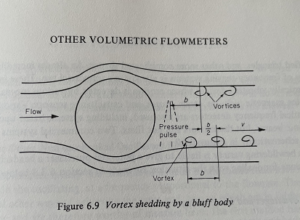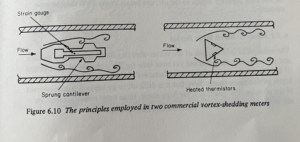How they work
How do you make a band play if it is an elastic one? Easy- just take it in your two hands, stretch it in front of your face about an inch away from your lips, and then blow on it. When the relationship between the tension in the rubber band and the air velocity is just right, the band will hum quite loudly.
This happens because a succession of fluid vortices is emitted from the trailing edges of a body placed across a flowing stream(Figure 6.9). The only way to prevent this is by streamlining the body; conversely, the vortex effect can be enhanced by using what is known as a “bluff body”-that is, something shaped as awkwardly as possible, such as a prism whose cross-section is a rectangle or a triangle with its apex pointing downstream. As Figure 6.9 indicates, the vortices are emitted alternately from opposite sides of the obstruction with a distance b between adjacent vortices. In an ideal fluid their frequency, v/b, will be proportional to the fluid velocity. Associated with each vortex is what amounts to a pressure pulse, and so when the vortex frequency happens to equal the natural frequency of the obstruction it will resonate. Hence the noise emitted by your elastic band, whispering pines, and the Aeolian harp of the Greeks.
Within the past few years, a considerable number of flowmeters employing this principle have appeared on the market. They all consist of a spool of pipe containing a bluff-shaped rod lying across one diameter, and some means of sensing the frequency of vortex.
From there on, however, each manufacturer is on his own. They all seem to use different cross-sections for the bluff body, including a circle, rectangles, modified triangles, and other more complicated shapes. An almost incredible variety of frequency detectors are also used, including systems based upon ultrasonic beams, hot thermistors, and hot films. Two commercial systems are shown schematically in Figure 6.10.
This bewildering variety is liable to give a potential purchaser headache. Suggestions for dealing with the situation are made in section 6.3.3 below.
Advantages and disadvantages
Vortex meters are aimed at much the same section of the markets as orifice plates. The vortex has in general about the same moderate accuracy as the orifice plate(under favorable circumstances it can be more accurate), a similar head loss, and much the same sensitivity to upstream flow disturbances. As with the orifice plate, it is not necessary for every individual meter to be calibrated, since its flow characteristics can be predicted with reasonable accuracy. Like the orifice plate, it has no rotating mechanisms to wear or break down, and it can be designed to operate with both gases and liquids, either clean or dirty.
There the resemblance ceases. The vortex meter scores over the orifice plate by having a linear output, rather better repeatability, a much wider rangeability(10:1 is easily obtained and under favorable conditions, this can be greatly exceeded), and a direct digital output. Moreover, if the cost of the associated differential-pressure transducer is added to that of an orifice plate, the vortex can actually be cheaper than the orifice plate in sizes below about 200mm diameter. As the size increases, however, the vortex becomes progressively less competitive in price. Also, because the K-factor of vortex meters is inversely proportional to D3, the pulse generation rate of large meters is so low that it is difficult to calibrate them accurately.
For vortex meters to give their optimum performance the flow must well into the turbulent range. At pipe Reynolds numbers below about 20 or 30 000 their accuracy begins to fall off, and below about 3000 they become unusable.
Points to watch when buying
The widespread introduction of the vortex meter has been so sudden and so recent that there has not yet been time for the principle of”the survival of the fittest” to operate. Some manufacturers’ designs are bound to give a better performance than others, but it is difficult to go beyond that statement of the obvious. The position is far from static since most manufacturers are still in the process of updating and perfecting their designs.
While this situation continues it behooves an intending purchaser to tread warily. When writing for quotations you should state precisely what you want the vortex to do; ask each manufacturer if his product will do it, and-especially-ask for the experimental evidence on which he bases his answer.


